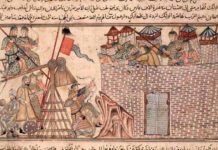The Southeast Asian region, located north of Australia, south of China, and east of India, and comprising the nations Brunei, Cambodia, East Timor, Indonesia, Laos, Malaysia, Myanmar, The Philippines, Singapore, Thailand and Vietnam, is remarkable for its intense diversity.
Nevertheless, there are a few historical events that have impacted the region as a whole. These could be considered, in a broad sense, common features in the development for each individual country, and the experience for the people within these countries.
Colonial Legacy in Southeast Asia
One such shared legacy is the influence of colonialism. Every country within the region has been colonized with the exception of Thailand. However, as it also faced encroachment by the surrounding British and Dutch colonial powers, colonialism can be still be seen overall to have had a profound effect on the region.
A focus of the more recent history (1870 – present) of the region could comprise of three parts:
- How the colonial power ruled the country
- How nationalism (such as in Indonesia) arose and Independence (such as in Vietnam) was achieved
- How the influences of colonial rule in the now independent nations are handled today (For instance, the concept of Asian Values)
A notable feature of the colonial legacy is the concept of the nation-state by the demarcation of a country by territorial boundaries, and the eventual acceptance of this mode of political definition and rule rather than a reversion to pre-colonial systems influences by monarchs, sultans and other forms of royalty. This is seen in the Dutch’s original definition of their sphere of influence over a vast archipelago of islands in what was previously the East Indies eventually becoming Indonesia.
Nevertheless, colonialism is only a similarity in the broadest sense. Given the different conditions of each country as well as the attitudes and methods of the colonial powers, the countries were often ruled differently. Direct and indirect rule is one such example where colonial rule manifested differently for countries.
Japanese Occupation in World War Two
The Japanese conquest in Southeast Asia during World War II, and imposition of the Greater East Asia Co-Prosperity Sphere had far reaching effects. Besides the physical upheaval in the destruction and poverty that accompanied the war and the years of rule by the Japanese, the victory did much to usurp, in the minds of the Southeast Asian people, their acceptance of be rule by western colonial powers.
Indeed, the period after Japan’s surrender marks the start of a time in which Southeast Asian countries increasingly sought for and achieved independence.
Again, there are prevalent differences even within this. The attitudes of various nations towards the Japanese ranged on a spectrum from perceiving them as liberators, to the revulsion of their invasion as conquerors, or even ambivalence as there was a mixture of empowerment and subjugation in their rule.
ASEAN’s Role in Continued Regional Development
The Association of South East Asian Nations, has come a long way since its founding in 1967. Today, it plays a role in the ensuring the economic growth, social progress, continuing peace and upholding of law. (Summarised from the ASEAN Secretariat)
ASEAN’s involvement in areas such as the political, human rights, and environmental arenas have left their mark on history, whether celebrated for their success or criticised for failures. However, as over time, all countries (with the exception of East Timor which is envisioned to be admitted in about 2011) in the region have accepted membership as well as stated their commitments towards the organisation, ASEAN can be seen as having an increasingly important, and optimistic role in the continued development on the Southeast Asian region.
Importance of A Knowledge of Southeast Asian History
The dynamics of Southeast Asian history are remarkably complex. Despite broadly similar historical events, attempts to describe, narrate, or the region’s history have to be drawn from a broad base of information to represent each country’s individual development. When describing the region as a whole, or even comparing just a few countries, explanations often need to be laden with qualifiers to strike a balance between finding trends and similar characteristics, and paying attention to unique areas.
Nevertheless, knowledge of Southeast Asian history is important, and worth devoting time, for many reasons.
References:
- A Short History of South-east Asia (3rd edition) by Peter Church (published 2003)
- The Emergence of Modern Southeast Asia Edited by Normal G. Owen et al. (published 2005)








